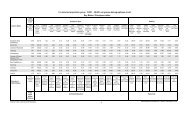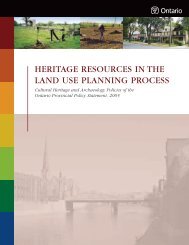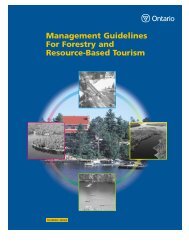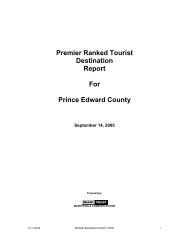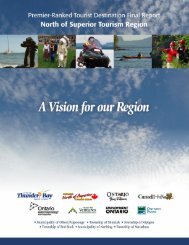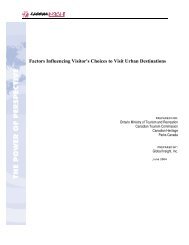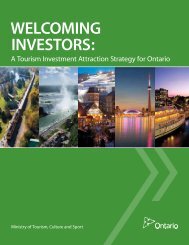Cultural Heritage Resources - Ministry of Tourism
Cultural Heritage Resources - Ministry of Tourism
Cultural Heritage Resources - Ministry of Tourism
You also want an ePaper? Increase the reach of your titles
YUMPU automatically turns print PDFs into web optimized ePapers that Google loves.
2.1: Key TermsThis section provides further detail on some <strong>of</strong> the important terms in section 23 <strong>of</strong> O.Reg. 359/09.Section 23 <strong>of</strong> O. Reg. 359/09 outlines therequirements <strong>of</strong> the heritage assessment. Theheritage assessment must include historicalresearch and a visual inspection to determinewhether there is potential for heritageresources, or abutting protected properties.Below are some <strong>of</strong> the key terms and conceptsthat will be relevant to this report. Please note thatthe assessment should be conducted by aqualified person, and the report must provide asummary <strong>of</strong> the qualifications and experience <strong>of</strong>the person(s) who conducted the assessment andprepared the report.<strong>Heritage</strong> <strong>Resources</strong>Under O. Reg. 359/09 a heritage resource refersto real property that is <strong>of</strong> cultural heritage value orinterest and may include a building, structure,landscape or other feature <strong>of</strong> real property.Generally speaking, heritage resources would bedivided into built heritage resources and culturalheritage landscapes. Of particular importance forconsideration within the context <strong>of</strong> renewableenergy projects is the inter-relationship between abuilding, structure or ruin with the surroundinglandscape including significant views from and <strong>of</strong>the heritage resource.Consideration <strong>of</strong> all heritage resources includesresources that have not yet been identified assignificant, that are identified through the research,evaluation and assessment process. It alsoincludes resources that have been previouslyidentified or commemorated by the community,province or in the national context (e.g., a propertythat is listed on the municipal register, identifiedwith a local plaque, included on a local walkingtour, the subject <strong>of</strong> a provincial plaque, ordesignated a National Historic Site).Built <strong>Heritage</strong> <strong>Resources</strong>:Examples <strong>of</strong> built heritage resources include:residential structures, farm buildings, mills,industrial, commercial, institutional buildings,bridges, water systems, dams, canals, locks,cairns, statues, monuments, fountains, retainingwalls, boundary or claim marker, or ruins.<strong>Cultural</strong> <strong>Heritage</strong> Landscapes<strong>Cultural</strong> heritage landscapes provide the context,setting or support for the character <strong>of</strong> an area.<strong>Cultural</strong> heritage landscapes are groupings <strong>of</strong>buildings, structures, spaces, archaeologicalsites, and/or natural elements that collectively aresignificant or representative. Examples include:burial sites, cemeteries, historic roadways, railcorridors, waterscapes, historical settlements,battlefields, streetscapes, agricultural landscapes,a park or designed recreational community space,or a heritage conservation district.The following definitions <strong>of</strong> cultural heritagelandscapes are taken from the OperationalGuidelines adopted by the United NationsEducational, Scientific and <strong>Cultural</strong> Organization(UNESCO) World <strong>Heritage</strong> Committee in 1992,and are widely accepted as the three primarylandscape types:Designed landscapes: those which have beenintentionally designed (e.g., a planned gardenor downtown square).Evolved landscapes: those which haveevolved through use by people whoseactivities have directly shaped the landscapeor area. This can include continuing orongoing use, or a relict landscape where theevolutionary processes has come to an end(e.g., an abandoned mine or historicalsettlement area).Associative landscapes: those with powerfulreligious, artistic, or cultural associations <strong>of</strong> thenatural element, as well as with materialcultural evidence (e.g., a sacred site within anatural environment or an historic battlefield).These landscapes may have material culturalevidence or material culture may be absent.Abutting Protected PropertiesProperties that share a common boundary orborder, or overlap for some distance areconsidered abutting. For the purposes <strong>of</strong>renewable energy projects, the term ‘abutting’ also5


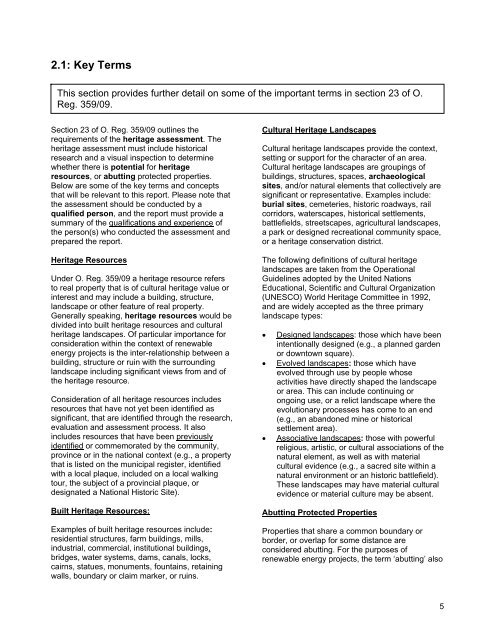
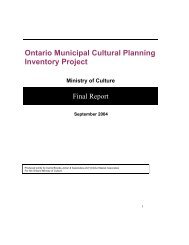
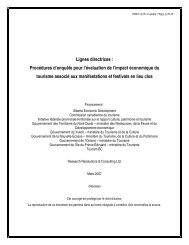
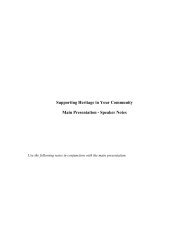
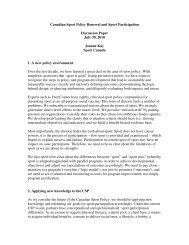
![THIS AGREEMENT made this [date], between [name of owner] (the ...](https://img.yumpu.com/49827605/1/158x260/this-agreement-made-this-date-between-name-of-owner-the-.jpg?quality=85)

